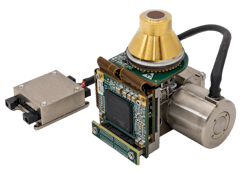SCD awarded several contracts to supply MWIR high-definition detectors
Semi Conductor Devices (SCD; Haifa, Israel), which makes cooled and uncooled infrared detectors, has won several contracts in North America and Europe for the supply of mid-wave infrared (MWIR) high-definition (HD) detectors for observation and surveillance applications. The contracts have a total value of more than $40M, says SCD.
SCD’s advanced HD MWIR detector product lines are used in airborne, ground, and naval applications. The contracts were recently signed with three different customers for applications including border surveillance, infrastructure protection, counter-UAV systems, and long-range airborne surveillance. Deliveries will begin in the third quarter of 2019.
These SCD detectors will be integrated into the above-mentioned programs in North America and Europe:
--Blackbird SXGA 10-µm pitch InSb/XBn is an MWIR high-definition detector for persistent surveillance applications, long/medium-range surveillance and targeting, IRST, IRMWS, and thermography. The compact system provides high image quality and high frame rate. Features include digital readout integrated circuit (ROIC), compact and ruggedized Dewar, integrated electronics with nonuniformity correction (NUC), bad-pixel replacement (BPR), digital zoom, graphic overlay support, and spatial and temporal noise reduction.
--Mini Blackbird SXGA 10-µm pitch XBn is one of the smallest HD MWIR detectors in its category, suited to a variety of Low SWaP-C applications including small and tactical payloads for mini UAS and drones, ground-based and handheld surveillance systems, surveillance aircraft, and more. Features include digital ROIC, compact and ruggedized Dewar, integrated electronics with NUC, BPR, digital zoom, graphic overlay support, and spatial and temporal noise reduction.
--Hercules 15-µm pitch InSb is a megapixel IR detector for long-range surveillance, navigation payloads, reconnaissance, and IRST. Features include a camera link interface, high frame rate at full window, long-term NUC stability, high linearity, and low residual nonuniformity, digital ROIC yielding low noise at system level, reduced size of system electronics, and low power consumption.
For info on SCD, see www.scd.co.il.
Source: SCD

John Wallace | Senior Technical Editor (1998-2022)
John Wallace was with Laser Focus World for nearly 25 years, retiring in late June 2022. He obtained a bachelor's degree in mechanical engineering and physics at Rutgers University and a master's in optical engineering at the University of Rochester. Before becoming an editor, John worked as an engineer at RCA, Exxon, Eastman Kodak, and GCA Corporation.
